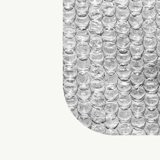Biocomposites to substitute plastic
Lead Organization: University of Copenhagen
Project Periode: October 2022 – April 2025
Pool: TRACE Pool 1
Project Status: Finalized
Agroindustrial side-streams will be exploited for cellulose nanofibers (CNF) that will form the basis for composite manufacture. Drop-in technology will be demonstrated with injection moulding as proof of concept, and applicability for food packaging will be evaluated.
Main challenges comprise removing water from CNF and integrate it with the matrix components amylose and bioresin so that optimal material properties are attained plus good processability.
Participating partners: University of Copenhagen, Nordic Sugar, Plantcarb ApS, Pond A/S, Leaf Packaging ApS
Researchers invent one hundred percent biodegradable "barley plastic"
A biofriendly new material made from barley starch blended with fibre from sugarbeet waste sees the light of day at the University of Copenhagen – a strong material that turns into compost should it end up in nature. In the long term, the researchers hope that their invention can help put the brakes on plastic pollution while reducing the climate footprint of plastic production.
"We have an enormous problem with our plastic waste that recycling seems incapable of solving. Therefore, we’ve developed a new type of bioplastic that is stronger and can better withstand water than current bioplastics. At the same time, our material is one hundred percent biodegradable and can be converted into compost by microorganisms if it ends up somewhere other than a bin," says Professor Andreas Blennow of the Department of Plant and Environmental Sciences.
Only about nine percent of plastic is recycled globally, with the rest being either incinerated or winding up in nature or dumped into enormous plastic landfills.
Bioplastics already exist, but the name is misleading says Professor Blennow. While today’s bioplastics are made of bio-derived materials, only a limited part of them is actually degradable, and only under special conditions in industrial composting plants.
"I don't find the name suitable because the most common types of bioplastics don't break down that easily if tossed into nature. The process can take many years and some of it continues to pollute as microplastic. Specialized facilities are needed to break down bioplastics. And even then, a very limited part of them can be recycled, with the rest ending up as waste," says the researcher.


Starch from barley and sugar industry waste
The new material is a so-called biocomposite and composed of several different substances that decompose naturally. Its main ingredients, amylose and cellulose, are common across the plant kingdom. Amylose is extracted from many crops including corn, potatoes, wheat and barley.
Together with researchers from Aarhus University, the research team founded a spinoff company in which they developed a barley variety that produces pure amylose in its kernels. This new variety is important because pure amylose is far less likely to turn into a paste when it interacts with water compared to regular starch. Cellulose is a carbohydrate found in all plants and we know it from cotton and linen fibers, as well as from wood and paper products. The cellulose used by the researchers is a so-called nanocellulose made from local sugar industry waste. And these nanocellulose fibers, which are one thousand times smaller than the fibers of linen and cotton, are what contribute to the material’s mechanical strength.
"Amylose and cellulose form long, strong molecular chains. Combining them has allowed us to create a durable, flexible material that has the potential to be used for shopping bags and the packaging of goods that we now wrap in plastic," says Andreas Blennow.
The new biomaterial is produced by either dissolving the raw materials in water and mixing them together or by heating them under pressure. By doing so, small 'pellets' or chips are created that can then be processed and compressed into a desired form.
Thus far, the researchers have only produced prototypes in the laboratory. But according to Professor Blennow, getting production started in Denmark and many other places in the world would be relatively easy.
"The entire production chain of amylose-rich starch already exists. Indeed, millions of tons of pure potato and corn starch are produced every year and used by the food industry and elsewhere. Therefore, easy access to the majority of our ingredients is guaranteed for the large-scale production of this material," he says.
Could reduce plastic problem
Andreas Blennow and his fellow researchers are now processing a patent application that, once it has been approved, could pave the way for production of the new biocomposite material. Because, despite the huge sums of money being devoted to sorting and recycling our plastic, the researcher does not believe that it will really be a success. Doing so should be seen as a transitional technology until we bid fossil-based plastics a final farewell.
"Recycling plastic efficiently is anything but straightforward. Different things in plastics must be separated from each other and there are major differences between plastic types, meaning that the process must be done in a safe way so that no contaminants end up in the recycled plastic. At the same time, countries and consumers must sort their plastic. This is a massive task that I don’t see us succeeding at. Instead, we should rethink things in terms of utilizing new materials that perform like plastic, but don’t pollute the planet," says Blennow.
The researcher is already collaborating with two Danish packaging companies to develop prototypes for food packaging, among other things. He envisions many other uses for the material as well, such as for the interior trims of cars by the automotive industry. Though it is difficult to say when this biofriendly barley-based plastic will reach the shelves, the researcher predicts that the new material may become a reality in the foreseeable future.
“It's quite close to the point where we can really start producing prototypes in collaboration with our research team and companies. I think it's realistic that different prototypes in soft and hard packaging, such as trays, bottles and bags, will be developed within one to five years," concludes Andreas Blennow.

About the research:
- The Department of Plant and Environmental Sciences researchers have founded PlantCarb Aps, a spin-off company, in collaboration with Associate Professor Kim Hebelstrup from Aarhus University, to produce the special starch from barley plants.
- The researchers are additionally partnering with Nordic Sugar, which supplies them with cellulose waste from sugar production, with Pond Global which develops bio-based matrices and Leaf packaging, a start-up and provider of food packaging materials.
- The research team comprises Jens Risbo, Andreas Blennow, Peter Ulvskov, Kim Hebelstrup, Marwa Faisal
The studies have been published as part of the Trace-project Biocomposites to Substitute Plastic.
- Xu J, Sagnelli, D, Faisal M, Perzon A, Taresco V, Mais M, Giosafatto CVL, Hebelstrup K, Ulvskov P, Jørgensen B, Chen L, Howdle S, Blennow A (2021) Amylose/cellulose nanocomposites for all-natural materials. Carbohydr Polym. DOI: 10.1016/j.carbpol.2020.117277
- Faisal M, Kou T, Zhong Y, Blennow A (2022) High amylose-based bio composites: structures, functions and applications. Polymers, 14, 1235. https://doi.org/10.3390/polym14061235
- Kou T, Faisal M, Song J, Blennow A (2022) Polysaccharide-based nanosystems: a review, Critical Reviews in Food Science and Nutrition, DOI: +10.1080/10408398.2022.2104209
- Faisal M, Bevilacqua M, Bro R, Bordallo HN, Kirkensgaard JJK, Hebelstrup KH, Blennow A (2023) Colorimetric pH indicators based on well-defined amylose and amylopectin matrices enriched with anthocyanins from red cabbage. Int J Biol Macromol 250, 126250, https://doi.org/10.1016/j.ijbiomac.2023.126250Get
- Faisal M, Zmiric M, Kim, NQN, Bruun, S, Mariniello L, Famiglietti M, Bordallo HN, Kirkensgaard JJK, Jørgensen B, Ulvskov P, Hebelstrup KH, Blennow A (2023) A comparison of cellulose nanocrystals and nanofibers as reinforcements to amylose-based composite bioplastics. Coatings, 13, 1573. https://doi.org/10.3390/coatings13091573
News articles about the project:
- Article: Researchers invent one hundred percent biodegradable "barley plastic", published at "https://science.ku.dk/", 18 June 2024.
Project Leader

Peter Ulvskov
Mail: ulvskov@plen.ku.dk





